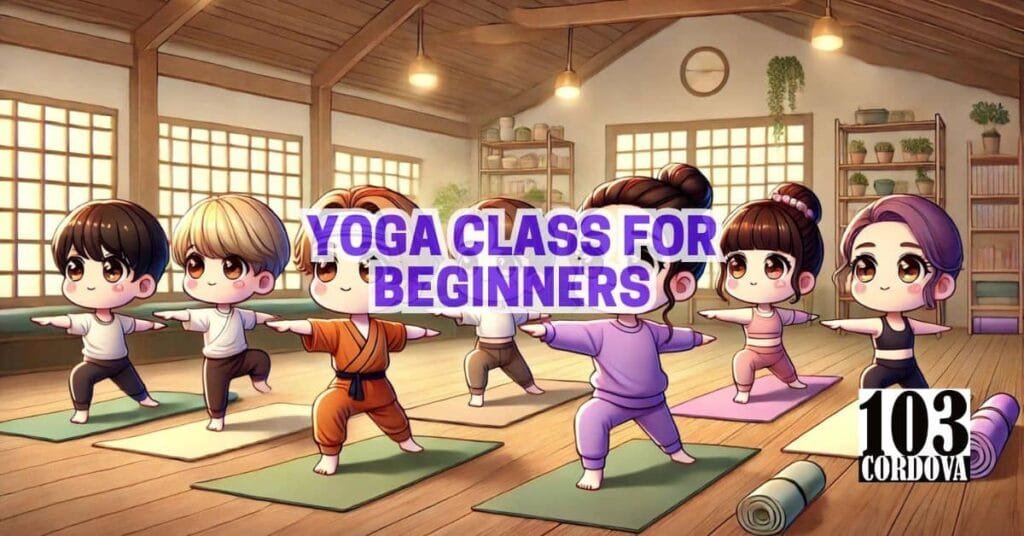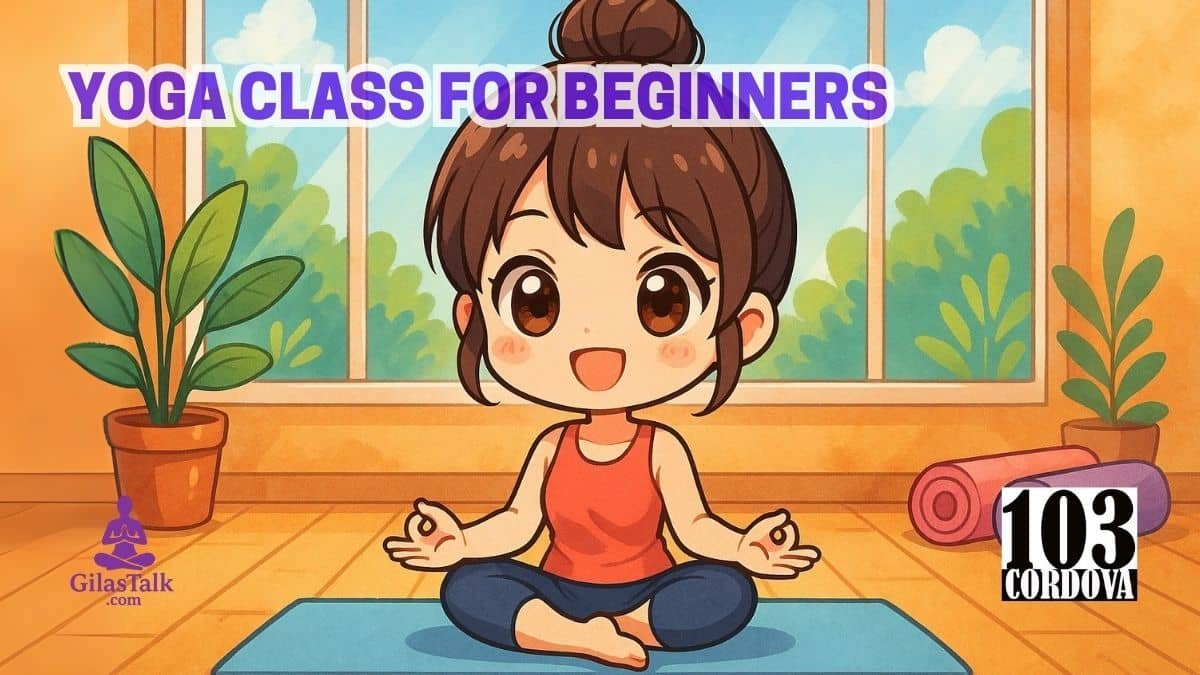Starting a yoga class for beginners can feel new and unfamiliar, but learning about common mistakes can make the process easier.
Yoga is more than physical movement because it also supports mental focus and emotional balance.
Many first-time students rush into poses or copy others without knowing how to protect their bodies.
Understanding the basics of safety, awareness, and preparation helps create a steady foundation for progress.
With this knowledge, beginners can enjoy yoga in a way that is safe, mindful, and rewarding.
1. The Importance of Warming Up Before Yoga
A common mistake many beginners make is skipping a warm-up before starting their yoga practice.
Warm-ups are essential because they prepare your muscles, joints, and ligaments for the movements ahead, which helps reduce the risk of injury.
Simple dynamic stretches or gentle poses, such as cat cow or spinal twist, slowly wake up the body and bring attention to how it feels.
Movements like these also increase blood flow, which improves flexibility and makes it easier to hold asanas during class.
For those in beginner yoga, practicing short sequences like the sun salutation can be a great way to connect breathing with movement while warming up.
This type of sequence is considered foundational because it teaches basic transitions that appear in many yoga classes.
Taking time to prepare in this way allows you to enter poses with more awareness and less tension.
By adding even a few minutes of warm-up, you create a safer, more focused, and more effective start to your practice.
🧘 Essential Tips on What to Wear to Yoga Class for Beginners
2. Wearing the Right Clothing and Using the Right Gear
Wearing clothes that are too loose or too tight can make it hard to move comfortably during yoga.
Choosing soft and stretchable fabrics allows your body to bend and stretch without restriction, which is especially important in beginner classes.
Shoes are not worn during yoga, since practicing barefoot improves balance, grounding, and connection to the mat.
A good non-slip mat gives stability, prevents sliding, and supports safe movement in both seated and standing postures.
Bringing simple gear, such as straps or blocks, can also make asanas more accessible for students who are new to the practice.
Selecting clothing and equipment that feels comfortable and supportive helps create an environment that encourages steady progress.
When you prepare this way, you set yourself up for the best yoga experience, one that is safe, focused, and enjoyable.
🧘 What is Kriya Yoga? How It Compares to Other Yoga Practices
3. Proper Alignment: Avoiding Strain and Injury
Beginners often struggle with maintaining proper alignment in yoga poses, which can lead to unnecessary strain or injury.
Correct alignment is important because it keeps the body safe while allowing you to receive the full benefits of different asanas.
A yoga teacher may demonstrate how to position the spine, shoulders, and hips so that each part of the body is supported.
Listening closely to a yoga instructor’s guidance also helps you notice small details, like how your feet are placed or how your weight is balanced.
Even small errors in posture can create stress on joints, muscles, and ligaments if repeated over time.
For example, rounding the lower back in forward bends or collapsing the chest in standing poses can limit progress and cause discomfort.
By making steady corrections and being open to feedback, beginners can protect themselves from long-term problems.
With consistent practice and mindful attention to form, alignment becomes second nature and leads to a stronger and more confident yoga journey.
🧘 How to Choose Between Vinyasa Vs Yin Yoga for Your Fitness Goals
4. Knowing Your Limits: Don’t Push Too Hard
It is common for beginners to want to master advanced poses quickly, but this can place the body at risk.
When you push past your current ability, you may experience soreness, muscle strains, or even long-term injury.
In yoga for beginners, it is important to focus on simple postures that build strength and balance before trying advanced asanas.
Listening to your body also helps prevent issues such as back pain, which is often made worse by forcing deep bends or twists.
Remember that yoga is not about achieving the most dramatic pose but about steady progress that supports overall health.
Respecting your body’s limits allows you to gain flexibility and stability in a safe way over time.
With patience and consistency, each practice becomes a step toward growth without the setbacks caused by overexertion.
🧘 Hot Yoga Vs Regular Yoga: Which One is Right for You?

5. Breath Awareness: The Key to a Successful Practice
Many beginners underestimate the importance of proper breathing in yoga, even though it is central to every pose.
Breathing works as a bridge between the mind and the body, helping you stay focused and aware during practice.
When you inhale deeply, you bring fresh energy into the body, and when you exhale fully, you release tension and allow the muscles to relax.
Coordinating breath with movement makes transitions smoother, especially in practices such as hatha yoga that emphasize steady and mindful pacing.
Without this awareness, students often hold their breath when a pose feels difficult, which can cause strain or create feelings of discomfort.
Practicing breath control also supports balance, as it keeps the body stable and the mind calm while holding asanas.
Over time, building this habit improves endurance and helps you remain centered even in more challenging sequences.
By paying attention to every inhale and exhale, you create a practice that strengthens the body while also bringing clarity and peace to the mind.
🧘 Ashtanga Yoga Vs. Vinyasa Yoga: Key Differences and Benefits Explained
6. Yoga Is Not a Competition: Embrace Your Journey
In a yoga class for beginners, it’s common to compare yourself to others, but this can lead to frustration.
Yoga is a deeply personal practice, and progress will look different for everyone.
Trying to keep up with more advanced students or pushing yourself too hard defeats the purpose of yoga.
Instead of striving to compete, focus on embracing your individual journey and recognizing the small improvements you make along the way.
Remember, yoga is about self-growth and mindfulness, not about achieving the “perfect” pose.
🧘 Why Chair Yoga Training Is Essential for Office Workers
7. Listening to Your Body: Modify When Necessary
It’s easy for beginners to push through discomfort, but this approach can lead to injury or burnout.
Yoga is meant to be nurturing for the body, so if a pose feels too intense or painful, it’s important to modify it.
Using gentler versions of poses or taking breaks when needed shows self-awareness, not weakness.
Many poses have accessible alternatives that provide the same benefits without putting strain on your body.
By listening to what your body needs in each moment, you create a practice that’s sustainable and supportive.
🧘 Why Somatic Yoga Training is a Game Changer for Stress Relief
8. Utilizing Props: Enhancing Your Practice
Beginners often hesitate to use props, thinking it diminishes their abilities, but props can actually enhance your practice.
Blocks, straps, and blankets are valuable tools that help you achieve proper alignment and deeper stretches.
Props make challenging poses more accessible by providing support where your body might need it.
For instance, using a block in a standing forward bend can help maintain alignment and avoid overstretching your hamstrings.
Incorporating props into your practice allows you to progress safely and comfortably, maximizing your benefits.
🧘 Can Heated Vinyasa Yoga Help You Lose Weight Effectively?
9. Taking Your Time: The Value of Mindful Movement
One common beginner mistake is rushing through poses without fully understanding or feeling them.
Yoga isn’t about how quickly you can move from one pose to the next but about how you transition mindfully.
Moving too fast can compromise alignment and cause unnecessary strain on your body.
Taking your time allows you to explore each pose with awareness, ensuring you’re engaging the right muscles and breathing properly.
Practice mindful movement to develop strength, balance, and flexibility in a safer and more focused way.
🧘 How to Learn Aerial Yoga Poses Names for a Better Practice
10. Connecting Mind and Body: Cultivating Awareness
Yoga is not just a physical exercise; it’s about connecting your mind and body to create a holistic practice.
Beginners often focus solely on achieving the physical poses and forget the mental aspect of yoga.
Cultivating awareness of how your body feels, where you hold tension, and how your breath flows can elevate your practice.
This connection allows you to better understand your body’s needs and respond to them with kindness.
In time, this awareness helps reduce stress, improve focus, and bring a sense of calm to both your practice and daily life.
🧘 Exploring the Benefits of Meditation and Yoga
11. Respecting Class Time: Why Staying Until the End Matters
Leaving a yoga class before it ends is a common mistake that can disrupt your experience and the flow of the class.
The final relaxation pose, Savasana, is just as important as the active poses because it allows your body and mind to integrate the benefits of the practice.
Skipping this part denies you the opportunity to rest and reset, which is crucial after physical exertion.
Staying until the end ensures you complete the practice with balance, leaving you feeling refreshed.
It also shows respect for both the instructor and your fellow students.
💡 Conclusion
Avoiding these common mistakes in a yoga class for beginners will help you build a strong and mindful practice.
Yoga is a journey that requires patience, and progress comes through consistency rather than quick results.
By paying attention to your body, breath, and form, you’ll see improvements in both your physical and mental well-being.
Embrace the process of learning and growing with each practice, trusting that each session brings you closer to your goals.
With time, yoga can become a transformative part of your life.
🤝 Our Friends’ Services
Experience the benefits of yoga with our classes designed for all ages at 103 Cordova Tower, Marquinton Residences, Cirma Street, Sto. Nino, Marikina City.
Our welcoming environment and experienced instructors are here to guide you, whether you’re a beginner or looking to deepen your practice.
We offer personalized attention to ensure every student feels supported and safe during their journey.
To learn more or book a class, reach out to us at 09176225780, via Facebook, or through the contact form on our website.
Start your wellness journey with us today!
❓ FAQs
1. How often should beginners practice yoga?
Beginners can start with two to three classes per week to build a steady routine.
This allows the body to adjust without becoming sore or overwhelmed.
Short home practices of 10 to 15 minutes can also help support progress.
With consistency, students will see improvements in strength, flexibility, and focus.
2. What should I bring to a yoga class for beginners?
The most important item is a good non-slip yoga mat.
Comfortable, stretchable clothing makes it easier to move and breathe.
Some studios provide props like blocks and straps, but you can bring your own if you prefer.
A small towel and a water bottle are also useful.
These simple items help make the class more comfortable and effective.
3. Can I eat before a yoga class?
It is best to avoid eating a heavy meal right before class.
Twists, forward bends, and other poses may feel uncomfortable with a full stomach.
A light snack like fruit or nuts one to two hours before class is usually fine.
After class, you can enjoy a more complete meal.
Listening to your body will help you find the right balance.
4. What should I do if I feel pain during a pose?
Pain is a signal that your body may be pushed too far.
Stop the movement right away and return to a safe, neutral position.
Ask your instructor for a modification or use props for support.
Never push through sharp or intense pain, as this can lead to injury.
Yoga should feel challenging but not harmful.
5. Do I need to be flexible to start yoga?
No, flexibility is not required to begin yoga.
Yoga helps you become more flexible over time, but it is also about strength, balance, and awareness.
Beginners often find that progress comes through patience and steady practice.
Everyone starts from a different place, and comparing yourself to others is not necessary.
What matters most is showing up and practicing at your own pace.

